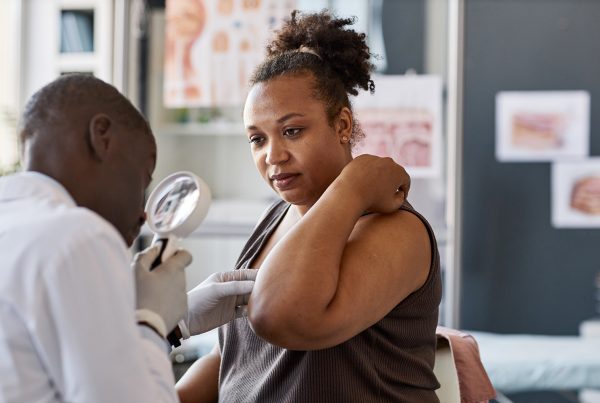One of the most vital steps you can take toward healthy skin is protecting it from the sun.
We often forget about how much our skin, the largest organ, does for us every day. It regulates our body temperature, provides us with the sensation of touch and shields us from the elements. It’s important to give our skin a little love in return.
“One of the most important steps you can take toward healthy skin is protecting it from the sun,” said David Crowe, MD, Chair of Dermatology at MetroHealth. Skin cancer risk increases as you get older because of cumulative effects of a lifetime of sun exposure. Areas of the skin with age spots, freckles and spider veins are especially vulnerable.
Stopping Skin Cancer Before It Starts
Dr. Crowe recommends the following tips for skin cancer prevention:
- Put on mineral sunscreen containing either zinc oxide or titanium dioxide. Be sure to reapply every couple of hours.
- Wear protective clothing that blocks the sun’s rays. Hats protect the top of your head and your face. Sun and swim shirts that contain ultraviolet protection factor (UPF) 50 can prevent sunburn.
- Seek out shade between 10 a.m. and 2 p.m. to avoid the sun at its full strength. People tend to forget to this rule, especially when they’re outdoors eating, doing yardwork or getting exercise.
- Schedule a regular skin exam with a dermatologist; if you have a history of skin cancer, these appointments may take place every 3 to 6 months.
- Know the signs of skin cancer. If you notice any abnormalities in your skin, call a dermatologist no matter what your age. The National Cancer Institute encourages patients to use the following criteria to identify a melanoma, the most serious form of skin cancer.
“ABCDE” Rule
The National Cancer Institute encourages patients to use the following criteria to identify a melanoma, the most serious form of skin cancer. Apply the “ABCDE” rule to your mole when examining its features:
A= Asymmetry: The shape of one half of a mole does not match the other half.
B = Border: The edges of the mole are irregular or ragged. The pigment may blur at the edges or spread into the surrounding skin.
C = Color: The mole may contain uneven shades of black, brown and tan, or areas of white, gray, red, pink or blue.
D = Diameter: The mole may increase in size; most melanomas are larger than ¼ inch in diameter.
E = Evolving: The mole changes in appearance over a few.
Take Advantage of New Technology
MetroHealth dermatologists offer the latest advancements to help identify skin cancer:
- Snapshot: A nurse takes three photos of a spot of concern that you’ve noticed on your skin. A high-resolution iPad camera captures images of moles and other skin lesions in detail, and a magnified image is obtained as well. The photos are uploaded into your personal health record and sent to a MetroHealth board-certified dermatologist for review. Within a week, you learn if an appointment is necessary for further examination. This free service is available at our main campus, as well as our Beachwood and Middleburg Heights health centers. Learn more at metrohealth.org/snapshot.
- SkinIO: A dermatology nurse takes photos of the entire body using an iPad. Artificial intelligence technology immediately flags any moles or areas of concern that a doctor should examine. The photos become part of your medical record and are monitored over time. You also have access to these images through a SkinIO app that you can download on your personal device. MetroHealth is the only hospital in Ohio to offer this photography-based mole mapping technology, available at our main campus. Learn more at metrohealth.org/skinIO.












